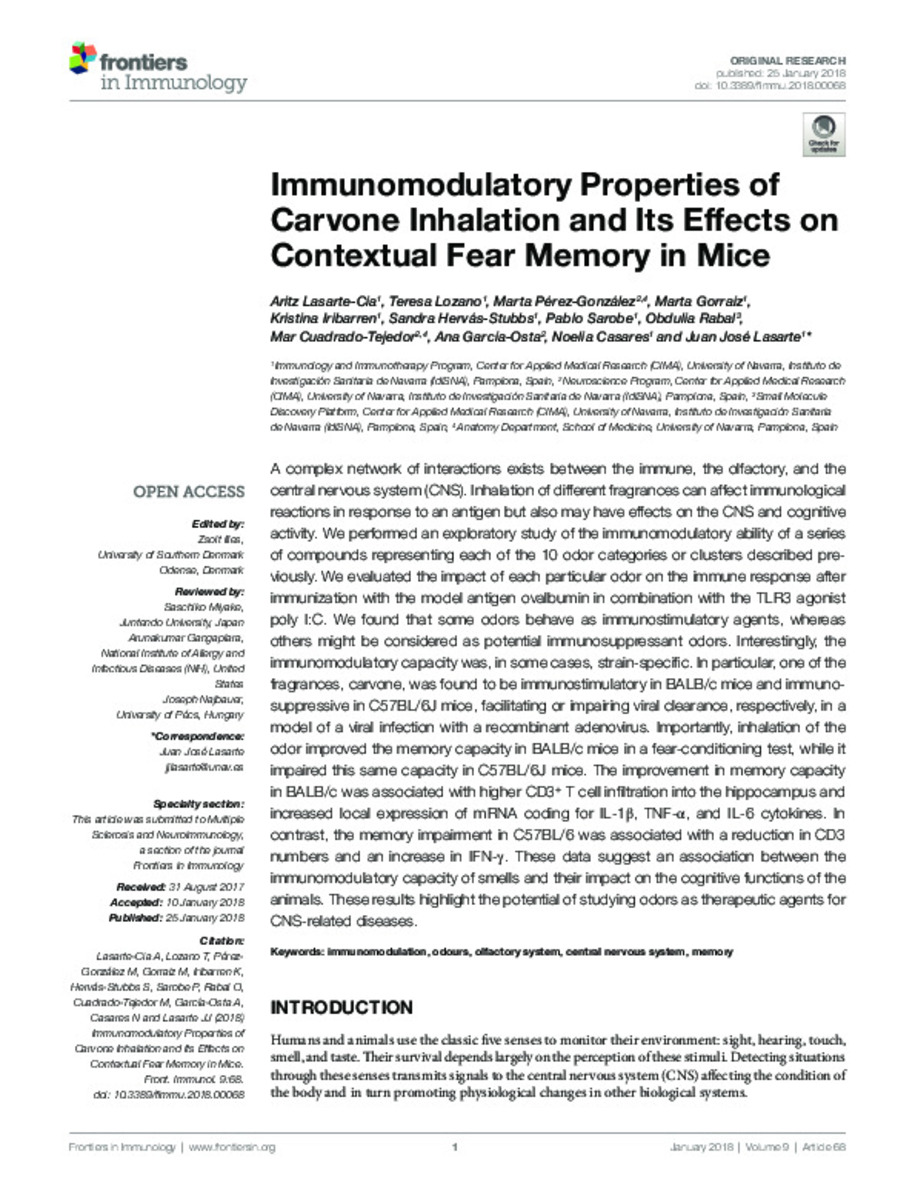Registro completo de metadatos
| Campo DC | Valor | Lengua/Idioma |
|---|---|---|
| dc.creator | Lasarte-Cia, A. (Aritz) | - |
| dc.creator | Lozano-Moreda, T. (Teresa) | - |
| dc.creator | Pérez-González, M. (Marta) | - |
| dc.creator | Gorraiz, M. (Marta) | - |
| dc.creator | Iribarren, K. (Kristina) | - |
| dc.creator | Hervas-Stubbs, S. (Sandra) | - |
| dc.creator | Sarobe, P. (Pablo) | - |
| dc.creator | Rabal, O. (Obdulia) | - |
| dc.creator | Cuadrado-Tejedor, M. (Mar) | - |
| dc.creator | Garcia-Osta, A. (Ana) | - |
| dc.creator | Casares, N. (Noelia) | - |
| dc.creator | Lasarte, J.J. (Juan José) | - |
| dc.date.accessioned | 2022-11-22T12:49:37Z | - |
| dc.date.available | 2022-11-22T12:49:37Z | - |
| dc.date.issued | 2018 | - |
| dc.identifier.citation | Lasarte-Cia, A. (Aritz); Lozano, T. (Teresa); Pérez-González, M. (Marta); et al. "Immunomodulatory properties of carvone inhalation and Its effects on contextual fear memory in mice". Frontiers in immunology. 9 (JAN), 2018, 68 | es |
| dc.identifier.issn | 1664-3224 | - |
| dc.identifier.uri | https://hdl.handle.net/10171/64711 | - |
| dc.description.abstract | A complex network of interactions exists between the immune, the olfactory, and the central nervous system (CNS). Inhalation of different fragrances can affect immunological reactions in response to an antigen but also may have effects on the CNS and cognitive activity. We performed an exploratory study of the immunomodulatory ability of a series of compounds representing each of the 10 odor categories or clusters described previously. We evaluated the impact of each particular odor on the immune response after immunization with the model antigen ovalbumin in combination with the TLR3 agonist poly I:C. We found that some odors behave as immunostimulatory agents, whereas others might be considered as potential immunosuppressant odors. Interestingly, the immunomodulatory capacity was, in some cases, strain-specific. In particular, one of the fragrances, carvone, was found to be immunostimulatory in BALB/c mice and immunosuppressive in C57BL/6J mice, facilitating or impairing viral clearance, respectively, in a model of a viral infection with a recombinant adenovirus. Importantly, inhalation of the odor improved the memory capacity in BALB/c mice in a fear-conditioning test, while it impaired this same capacity in C57BL/6J mice. The improvement in memory capacity in BALB/c was associated with higher CD3+ T cell infiltration into the hippocampus and increased local expression of mRNA coding for IL-1β, TNF-α, and IL-6 cytokines. In contrast, the memory impairment in C57BL/6 was associated with a reduction in CD3 numbers and an increase in IFN-γ. These data suggest an association between the immunomodulatory capacity of smells and their impact on the cognitive functions of the animals. These results highlight the potential of studying odors as therapeutic agents for CNS-related diseases. | es_ES |
| dc.description.sponsorship | This work was supported by grants from Ministerio de Economía y Competitividad, Spain (Explora SAF2013-50067-EXP and SAF2016-78568-R to JL). MPG is a fellow of Asociación de Amigos de la Universidad de Navarra (ADA). We thank Elena Ciordia and Eneko Elizalde for excellent animal care and Andoni Fourco for helping in the design of the vaporization system. The authors would like to thank Dr. Diego Alignani and Idoia Rodriguez-Serrano of the Flow Cytometry Facility at CIMA and Elisabeth Guruceaga, Lourdes Ortiz, and Victor Segura from the Bioinformatics Service at CIMA. | es_ES |
| dc.language.iso | eng | es_ES |
| dc.publisher | Frontiers Media | es_ES |
| dc.relation | info:eu-repo/grantAgreement/MINECO/Proyectos «Explora Ciencia» y «Explora Tecnología»/SAF2013-50067-EXP/ES/ESTIMULACION DEL SISTEMA NERVIOSO CENTRAL A TRAVES DEL SISTEMA OLFATIVO, COMO METODO DE POTENCIACION DE LA RESPUESTA INMUNE ANTITUMORAL Y ANTIVIRAL | es_ES |
| dc.rights | info:eu-repo/semantics/openAccess | es_ES |
| dc.subject | Immunomodulation | es_ES |
| dc.subject | Odours | es_ES |
| dc.subject | Olfactory system | es_ES |
| dc.subject | Central nervous system | es_ES |
| dc.subject | Memory | es_ES |
| dc.title | Immunomodulatory properties of carvone inhalation and Its effects on contextual fear memory in mice | es_ES |
| dc.type | info:eu-repo/semantics/article | es_ES |
| dc.description.note | This is an open-access article distributed under the terms of the Creative Commons Attribution License (CC BY). The use, distribution or reproduction in other forums is permitted, provided the original author(s) or licensor are credited and that the original publication in this journal is cited, in accordance with accepted academic practice. No use, distribution or reproduction is permitted which does not comply with these terms. | es_ES |
| dc.identifier.doi | 10.3389/fimmu.2018.00068 | - |
| dadun.citation.number | JAN | es_ES |
| dadun.citation.publicationName | Frontiers in immunology | es_ES |
| dadun.citation.startingPage | 68 | es_ES |
| dadun.citation.volume | 9 | es_ES |
Ficheros en este ítem:
Estadísticas e impacto
Los ítems de Dadun están protegidos por copyright, con todos los derechos reservados, a menos que se indique lo contrario.






